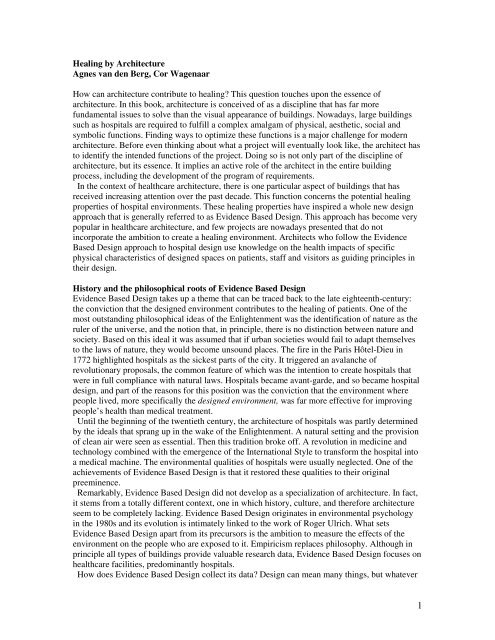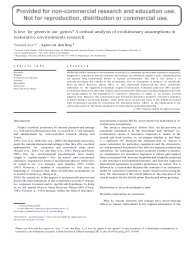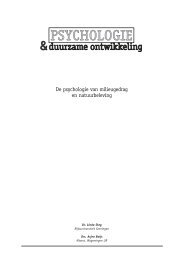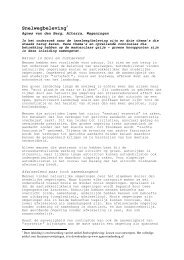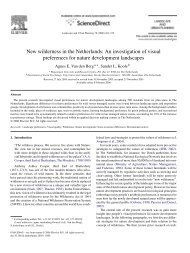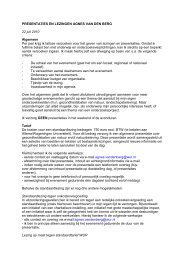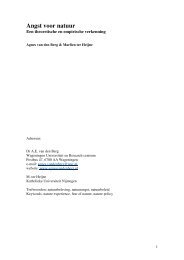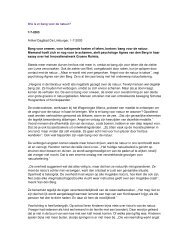Healing by Architecture Agnes van den Berg, Cor Wagenaar How ...
Healing by Architecture Agnes van den Berg, Cor Wagenaar How ...
Healing by Architecture Agnes van den Berg, Cor Wagenaar How ...
Create successful ePaper yourself
Turn your PDF publications into a flip-book with our unique Google optimized e-Paper software.
<strong>Healing</strong> <strong>by</strong> <strong>Architecture</strong><br />
<strong>Agnes</strong> <strong>van</strong> <strong>den</strong> <strong>Berg</strong>, <strong>Cor</strong> <strong>Wagenaar</strong><br />
<strong>How</strong> can architecture contribute to healing? This question touches upon the essence of<br />
architecture. In this book, architecture is conceived of as a discipline that has far more<br />
fundamental issues to solve than the visual appearance of buildings. Nowadays, large buildings<br />
such as hospitals are required to fulfill a complex amalgam of physical, aesthetic, social and<br />
symbolic functions. Finding ways to optimize these functions is a major challenge for modern<br />
architecture. Before even thinking about what a project will eventually look like, the architect has<br />
to i<strong>den</strong>tify the intended functions of the project. Doing so is not only part of the discipline of<br />
architecture, but its essence. It implies an active role of the architect in the entire building<br />
process, including the development of the program of requirements.<br />
In the context of healthcare architecture, there is one particular aspect of buildings that has<br />
received increasing attention over the past decade. This function concerns the potential healing<br />
properties of hospital environments. These healing properties have inspired a whole new design<br />
approach that is generally referred to as Evi<strong>den</strong>ce Based Design. This approach has become very<br />
popular in healthcare architecture, and few projects are nowadays presented that do not<br />
incorporate the ambition to create a healing environment. Architects who follow the Evi<strong>den</strong>ce<br />
Based Design approach to hospital design use knowledge on the health impacts of specific<br />
physical characteristics of designed spaces on patients, staff and visitors as guiding principles in<br />
their design.<br />
History and the philosophical roots of Evi<strong>den</strong>ce Based Design<br />
Evi<strong>den</strong>ce Based Design takes up a theme that can be traced back to the late eighteenth-century:<br />
the conviction that the designed environment contributes to the healing of patients. One of the<br />
most outstanding philosophical ideas of the Enlightenment was the i<strong>den</strong>tification of nature as the<br />
ruler of the universe, and the notion that, in principle, there is no distinction between nature and<br />
society. Based on this ideal it was assumed that if urban societies would fail to adapt themselves<br />
to the laws of nature, they would become unsound places. The fire in the Paris Hôtel-Dieu in<br />
1772 highlighted hospitals as the sickest parts of the city. It triggered an avalanche of<br />
revolutionary proposals, the common feature of which was the intention to create hospitals that<br />
were in full compliance with natural laws. Hospitals became a<strong>van</strong>t-garde, and so became hospital<br />
design, and part of the reasons for this position was the conviction that the environment where<br />
people lived, more specifically the designed environment, was far more effective for improving<br />
people’s health than medical treatment.<br />
Until the beginning of the twentieth century, the architecture of hospitals was partly determined<br />
<strong>by</strong> the ideals that sprang up in the wake of the Enlightenment. A natural setting and the provision<br />
of clean air were seen as essential. Then this tradition broke off. A revolution in medicine and<br />
technology combined with the emergence of the International Style to transform the hospital into<br />
a medical machine. The environmental qualities of hospitals were usually neglected. One of the<br />
achievements of Evi<strong>den</strong>ce Based Design is that it restored these qualities to their original<br />
preeminence.<br />
Remarkably, Evi<strong>den</strong>ce Based Design did not develop as a specialization of architecture. In fact,<br />
it stems from a totally different context, one in which history, culture, and therefore architecture<br />
seem to be completely lacking. Evi<strong>den</strong>ce Based Design originates in environmental psychology<br />
in the 1980s and its evolution is intimately linked to the work of Roger Ulrich. What sets<br />
Evi<strong>den</strong>ce Based Design apart from its precursors is the ambition to measure the effects of the<br />
environment on the people who are exposed to it. Empiricism replaces philosophy. Although in<br />
principle all types of buildings provide valuable research data, Evi<strong>den</strong>ce Based Design focuses on<br />
healthcare facilities, predominantly hospitals.<br />
<strong>How</strong> does Evi<strong>den</strong>ce Based Design collect its data? Design can mean many things, but whatever<br />
1
its precise definition, the term always refers to environmental aspects. Most tests of impacts of<br />
environmental aspects are comparative. Groups of patients who are in multiple bedrooms are<br />
compared to patients with a similar medical record, but who spend their time in single bedrooms.<br />
In the same way, the effects of rooms with or without a view on nature are being compared. Even<br />
the effects of paintings on the bedroom walls have been evaluated: what are the effects of abstract<br />
painting relative to the impact of paintings depicting natural scenery? Remarkably, the impact of<br />
color is almost neglected, though precisely in this field a lot could have been gained <strong>by</strong> referring<br />
to existing, groundbreaking research. 1 Most of the results focus on stress outcomes: do specific<br />
environmental qualities increase stress, or do they help to calm patients?<br />
As Evi<strong>den</strong>ce Based Design developed and gained ground, all effects that could be attributed to<br />
environmental causes were accepted as evi<strong>den</strong>ce, and psychology became less important. These<br />
effects can be manifold: apart from ‘health outcomes’, the prevention of injuries (<strong>by</strong> falling out of<br />
bed, for instance), reduction of pathogens in the air, lower levels of medical errors, and better<br />
acoustics are also considered as evi<strong>den</strong>ce. Remarkably, although Evi<strong>den</strong>ce Based Design focuses<br />
on people’s reactions, it is hardly ever interested in their opinions. Instead of mapping people’s<br />
ideas and views, it concentrates on their ‘primary reactions’. These ‘primary’ reactions are<br />
considered hard, objective data, that are not influenced <strong>by</strong> response bias or other social or cultural<br />
values. The notion that primary data are the only valid source of evi<strong>den</strong>ce appears to be<br />
intrinsically linked to a view of patients in hospitals as mere biological entities who have returned<br />
to their pure, natural state, finally released of the bur<strong>den</strong> of culture, education, and social class. A<br />
view that can easily be traced back to Enlightenment ideals that portrayed civilization as a<br />
negative influence that leads humans away from their essence.<br />
Evi<strong>den</strong>ce Based Design opens prospects of a pristine, crystal clear universe, untainted <strong>by</strong> the<br />
stains of history, resulting in an environment that fulfils basic human needs without blurring them<br />
<strong>by</strong> the ephemeral symbols determined <strong>by</strong> rapidly changing political and economic trends. What a<br />
glorious perspective, what a revolutionary view – but is it really valid? <strong>How</strong> hard is the evi<strong>den</strong>ce?<br />
Isn’t this ideal inspired <strong>by</strong> philosophical positions as much as <strong>by</strong> empirical data? What would it<br />
mean to strip society of history? Where would it leave us? Would we see what Hans Castorp, the<br />
hero of Thomas Mann’s Magic Mountain, saw in the final scenes of this great novel? ‘Hans<br />
Castorp looked around. He saw something scary, evil, and he knew what it was: Life without<br />
time, life without worries nor hopes, life as stagnant, busy debauchery, dead life.’ 2 If Evi<strong>den</strong>ce<br />
Based Design wants to contribute to hospital as a vital part of society, it definitely needs to<br />
consider architecture in its full capacity, including its historical and cultural dimensions.<br />
Achieving this is precisely what the authors in this sections intend to contribute to.<br />
The Hard Facts<br />
Setting aside the philosophical roots and potential implications of Evi<strong>den</strong>ce Based Design, we<br />
may now take a look at the evi<strong>den</strong>ce base itself. <strong>How</strong> much evi<strong>den</strong>ce is available for the healing<br />
functions of architecture, and how good is the evi<strong>den</strong>ce base? Unfortunately, these questions are<br />
difficult to answer on the base of existing reviews that have been conducted <strong>by</strong> advocates of<br />
Evi<strong>den</strong>ce Based Design, such as the recent review <strong>by</strong> Ulrich et al.(2004) that was carried out<br />
under the auspices of the Center for Health Design. In line with recent developments in Evi<strong>den</strong>ce<br />
Based Design, this review has taken a broad scope, including evi<strong>den</strong>ce on impacts of<br />
1 An epochal work in this respect is Antal Nemcsics, Colour Dynamics. Environmental Colour Design,<br />
Budapest 1993.<br />
2 ‘Hans Castorp blickte ums sich... Er sah durchaus Unheimliches, Bösartiges, und er wußte, was er sah:<br />
Das Leben ohne Zeit, das sorg- und hoffnungslose Leben, das Leben als stagnierende betriebsame<br />
Liederlichkeit, das tote Leben.’ Thomas Mann, Der Zauberberg, Frankfurt am Main 2001 (first published<br />
in 1924), 863.<br />
2
environmental features that are not central to architecture, such as antiseptic soap dispensers, and<br />
evi<strong>den</strong>ce on environmental impacts that are only indirectly related to healing, such as impacts on<br />
acoustics and job turnover rates of hospital staff.<br />
To obtain a more accurate estimate of the amount and quality of the evi<strong>den</strong>ce base, the project<br />
The <strong>Architecture</strong> of Hospitals has commissioned a new review of evi<strong>den</strong>ce for healing properties<br />
of hospital environments. The scope of this review was more closely aligned to conventional<br />
definitions of the concepts of ‘architecture’, ‘healing environment’, and ‘health’. 3 This review<br />
focused on four key features of hospital buildings that have traditionally been considered<br />
components of healing environments: nature, daylight, fresh air and quiet. The review was<br />
restricted to medical and psychological health outcomes. A distinction was made between clinical<br />
evi<strong>den</strong>ce (e.g., evi<strong>den</strong>ce from studies conducted in healthcare settings or among clinical<br />
populations) and non-clinical evi<strong>den</strong>ce. Evi<strong>den</strong>ce was classified as ‘strong’ or ‘weak’ based on<br />
the quality of the research design and the rele<strong>van</strong>ce of the environmental manipulation to<br />
healthcare settings.<br />
A total of 97 studies were i<strong>den</strong>tified that fulfilled the criteria of the review. The outcomes of<br />
these studies provide sufficient evi<strong>den</strong>ce that presence of nature in or around buildings can<br />
positively influence health. More specifically, it has been demonstrated that viewing nature on a<br />
screen or through a window can reduce stress and pain, while presence of indoor plants can lift<br />
people’s mood and reduce self-reported symptoms of physical discomfort. Perhaps counterintuitively,<br />
the health benefits of direct contact with ‘real’ nature, such as a visit to a gar<strong>den</strong>, were<br />
found to be less well-established. The outcomes of the studies in the review also provide solid<br />
evi<strong>den</strong>ce that ventilation of fresh air can improve self-reported and medically diagnosed health.<br />
<strong>How</strong>ever, the evi<strong>den</strong>ce for health benefits of daylight in buildings was judged as weak and<br />
inconclusive, while the evi<strong>den</strong>ce for the health benefits of quiet was qualified as indirect.<br />
Although there is ample evi<strong>den</strong>ce for negative health impacts of noise, the role of the physical<br />
environment in producing or reducing negative health impacts of noise has only been<br />
demonstrated in a handful of studies.<br />
The review that was carried out for the project The <strong>Architecture</strong> of Hospitals focused only on a<br />
selection of environmental features that are rele<strong>van</strong>t to health and healing. As such, it does not<br />
provide a comprehensive overview of evi<strong>den</strong>ce for healing properties of architecture. In particular<br />
health benefits of frequently mentioned aspects such as color, personal space, personal control,<br />
and way-finding have not been addressed. Some of these aspects, such as personal space and<br />
interior design properties, are addressed in the articles in this section of the book. Both the review<br />
and the articles in this section confirm that there is sound evi<strong>den</strong>ce for the health impacts of<br />
healing environments which can no longer be ignored. <strong>How</strong> this evi<strong>den</strong>ce can be used to enrich<br />
the architecture of hospitals will be among the fundamental issues that will have to be addressed<br />
in the near future.<br />
Does healing <strong>by</strong> architecture imply that architecture should adopt the scientific approaches of<br />
medicine? Many of the articles collected here radiate a somewhat clinical atmosphere, an effect<br />
highlighted <strong>by</strong> many references (that were included in their original template). Though the<br />
emphasis on isolated aspects and statistical methods differs dramatically from the allegedly<br />
somewhat anarchistic and intuitive approach inherent in the science of architecture, it is hard to<br />
find intrinsic reasons for seeing them as incompatible.<br />
[Jane Malkin opens this part <strong>by</strong> demonstrating the immense importance of environmental<br />
considerations in the architecture of hospitals, making abundantly clear that architects and<br />
hospital managers alike should pay far more attention to these considerations, as they have a<br />
direct impact on the hospital's core functions.]<br />
Having its origins in environmental psychology and emulating the scientific methods of<br />
3 <strong>Agnes</strong> <strong>van</strong> <strong>den</strong> <strong>Berg</strong>, Health impacts of healing environments: A review of the benefits of nature, daylight,<br />
fresh air and quiet in healthcare settings, Groningen 2005.<br />
3
Evi<strong>den</strong>ce Based Medicine, Evi<strong>den</strong>ce Based Design impacts the world of architecture from<br />
outside, covering only part of the complete scope of the architect's work. That, naturally, makes<br />
the relation between the two an issue. Mardelle Shepley and Kirk Hamilton address this issue,<br />
Shepley starting with a methodological comparison, Hamilton from a best practice approach<br />
(focusing on architecture). Complex though the interaction between Evi<strong>den</strong>ce Based Design and<br />
<strong>Architecture</strong> may be, both articles clearly demonstrate that they can and should be reconciled.<br />
[Roger Ulrich, credited as the auctor intellectualis of Evi<strong>den</strong>ce Based Design, presents a general<br />
introduction of this still relatively new discipline, directing his message mainly at hospital<br />
managers and policy makers.]<br />
<strong>How</strong> Evi<strong>den</strong>ce Based Medicine works in practice is demonstrated in another article <strong>by</strong> Shepley,<br />
followed <strong>by</strong> the contributions of Marie-Andrée Fournier and Robert White. They focus on the<br />
neonatal intensive care units, pointing out, among other things, the single patient room solution as<br />
<strong>by</strong> far the best. Richard <strong>van</strong> Enk extends this view to all patient rooms, ushering in the end of the<br />
multiple bed wards.<br />
[<strong>How</strong> Evi<strong>den</strong>ce Based Design can help to reduce falls and enhance safety, two vital aspects in<br />
the architecture of hospital, is outlined in the second article Roger Ulrich contributes to this<br />
book.]<br />
Clare Cooper Marcus and Sandra Sherman close the circle <strong>by</strong> returning to the issues of nature in<br />
hospitals - the starting point of the modern hospitals over 250 years ago. The two articles<br />
demostrate how far Evi<strong>den</strong>ce Based Design has evolved from the purely philosophical level and<br />
to what extent scientifically oriented, empirical methods are the essence of this approach.<br />
4


